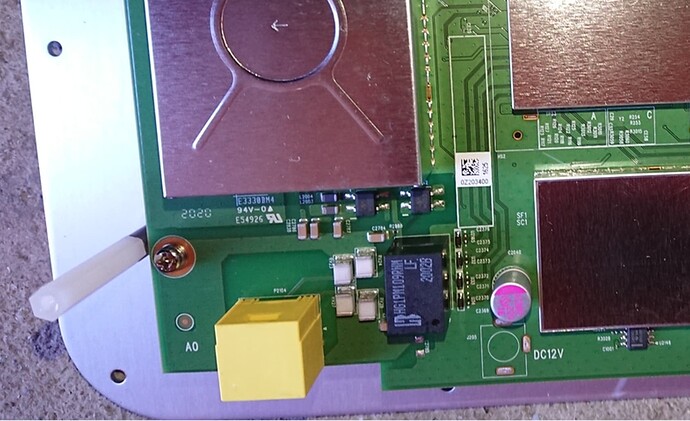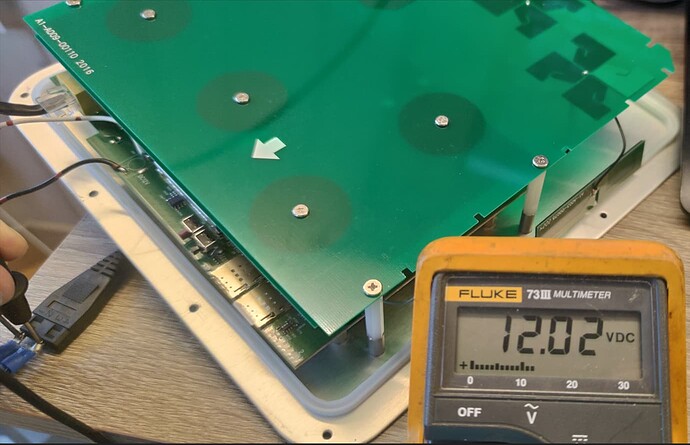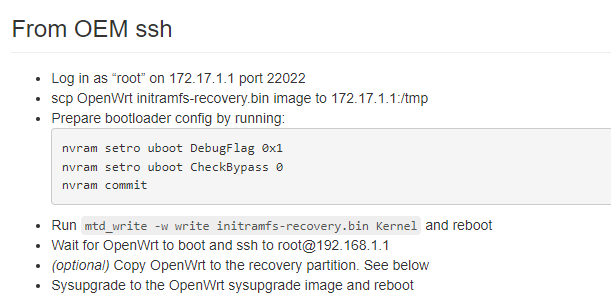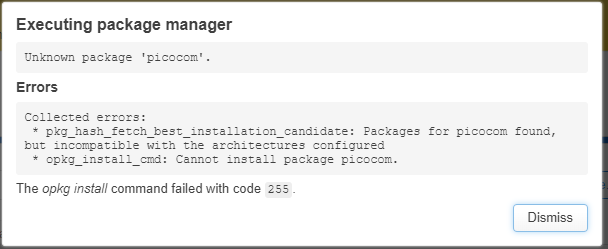root@NR7101:~# iptables -S
-P INPUT ACCEPT
-P FORWARD ACCEPT
-P OUTPUT ACCEPT
-N BAD_PING
-N FORWARD_CF
-N FORWARD_DMZ
-N FORWARD_DOS
-N FORWARD_GENERAL
-N FORWARD_GUESTAP
-N FORWARD_INTBLCK
-N FORWARD_IPPASS1
-N FORWARD_NAT
-N FORWARD_PARENTAL
-N FORWARD_PM
-N FORWARD_PM_UPNP
-N FORWARD_POLICY
-N FORWARD_PT
-N FORWARD_SESS_LIMIT
-N FORWARD_SRV
-N ICMP_REDIRECT
-N INPUT_CF
-N INPUT_CWMP
-N INPUT_DOS
-N INPUT_GENERAL
-N INPUT_GUESTAP
-N INPUT_IPPASS1
-N INPUT_REMOMGMT
-N INPUT_RIP
-N INPUT_SP_DOMAIN
-N INPUT_SRV
-N INPUT_TEST
-N LevelLow
-N NAT_LOOPBACK
-N OUTPUT_GENERAL
-N OUTPUT_SRV
-N PING_DEATH
-N PORT_SCAN
-N PR_IPPASS_CWMP1
-N PR_IPPASS_GENERAL1
-N PR_IPPASS_REMOMGMT
-N PR_IPPASS_REMOMGMT1
-N SP_LAN_PART
-N SP_TRUST_DOMAIN
-N SYN_FLOODING
-N Service_FTP
-N Service_HTTP
-N Service_HTTPS
-N Service_PING
-N Service_SSH
-N Service_TELNET
-N TRUST_DOMAIN
-N V4_PORT_REDIRECT
-A INPUT -j PR_IPPASS_CWMP1
-A INPUT -j PR_IPPASS_REMOMGMT1
-A INPUT -j PR_IPPASS_GENERAL1
-A INPUT -j INPUT_IPPASS1
-A INPUT -j V4_PORT_REDIRECT
-A INPUT -i lo -j ACCEPT
-A INPUT -j INPUT_TEST
-A INPUT -i br+ -m mark --mark 0x8/0x8 -j INPUT_GUESTAP
-A INPUT -j INPUT_DOS
-A INPUT -j INPUT_SRV
-A INPUT -j INPUT_SP_DOMAIN
-A INPUT -j INPUT_CWMP
-A INPUT -j INPUT_REMOMGMT
-A INPUT -j INPUT_CF
-A INPUT -j INPUT_GENERAL
-A INPUT -j INPUT_RIP
-A INPUT ! -i br+ -j DROP
-A FORWARD -j FORWARD_IPPASS1
-A FORWARD -j FORWARD_DMZ
-A FORWARD -i br+ -m mark --mark 0x8/0x8 -j FORWARD_GUESTAP
-A FORWARD -i br+ -j FORWARD_PARENTAL
-A FORWARD -j FORWARD_INTBLCK
-A FORWARD -j FORWARD_CF
-A FORWARD -j FORWARD_GENERAL
-A FORWARD -j FORWARD_DOS
-A FORWARD -j FORWARD_SRV
-A FORWARD -j FORWARD_NAT
-A FORWARD -j FORWARD_PM_UPNP
-A FORWARD -j FORWARD_POLICY
-A OUTPUT -j OUTPUT_GENERAL
-A OUTPUT -j OUTPUT_SRV
-A FORWARD_GENERAL -m state --state RELATED,ESTABLISHED -j ACCEPT
-A FORWARD_GUESTAP -i br+ -o wwan+ -j DROP
-A FORWARD_NAT -j FORWARD_PM
-A FORWARD_NAT -j FORWARD_SESS_LIMIT
-A FORWARD_NAT -j FORWARD_PT
-A FORWARD_POLICY -j LevelLow
-A FORWARD_SRV -i br+ -p tcp -m multiport --dports 23,21,20,80,443,25,53,110,995,220,143,993 -j ACCEPT
-A FORWARD_SRV -i br+ -p udp -m multiport --dports 80,443,53,110,995,220,143,993 -j ACCEPT
-A FORWARD_SRV -i br+ -p udp -m udp --dport 123 -j ACCEPT
-A FORWARD_SRV -i br+ -p udp -m udp --sport 67:68 --dport 67:68 -j ACCEPT
-A INPUT_GENERAL ! -i br+ -p tcp -m tcp --dport 53 -j DROP
-A INPUT_GENERAL ! -i br+ -p udp -m udp --dport 53 -j DROP
-A INPUT_GENERAL -i lo -p udp -m udp --dport 53 -j ACCEPT
-A INPUT_GENERAL ! -i br+ -p tcp -m tcp --dport 1900 -j DROP
-A INPUT_GENERAL ! -i br+ -p udp -m udp --dport 1900 -j DROP
-A INPUT_GENERAL ! -i br+ -p icmp -m icmp --icmp-type 13 -j DROP
-A INPUT_GENERAL -m state --state RELATED,ESTABLISHED -j ACCEPT
-A INPUT_GENERAL -i lo -j ACCEPT
-A INPUT_GENERAL -s 127.0.0.0/8 ! -i lo -j DROP
-A INPUT_REMOMGMT -j TRUST_DOMAIN
-A INPUT_REMOMGMT -p tcp -m tcp --dport 80 -j Service_HTTP
-A INPUT_REMOMGMT -p tcp -m tcp --dport 443 -j Service_HTTPS
-A INPUT_REMOMGMT -p tcp -m tcp --dport 21 -j Service_FTP
-A INPUT_REMOMGMT -p tcp -m tcp --dport 23 -j Service_TELNET
-A INPUT_REMOMGMT -p tcp -m tcp --dport 22022 -j Service_SSH
-A INPUT_REMOMGMT -p icmp -m icmp --icmp-type 8 -j Service_PING
-A INPUT_SRV -i br+ -p udp -m udp --dport 123 -j ACCEPT
-A INPUT_SRV ! -i br+ -p udp -m udp --dport 68 -j ACCEPT
-A INPUT_SRV -i br+ -p udp -m udp --dport 67 -j ACCEPT
-A LevelLow -i br+ -j ACCEPT
-A LevelLow ! -i br+ -j DROP
-A OUTPUT_GENERAL -o lo -j ACCEPT
-A OUTPUT_GENERAL -d 127.0.0.0/8 ! -o lo -j DROP
-A PR_IPPASS_REMOMGMT1 -i wwan0 -p tcp -m tcp --dport 80 -j DROP
-A PR_IPPASS_REMOMGMT1 -i eth+ -p tcp -m tcp --dport 80 -j DROP
-A PR_IPPASS_REMOMGMT1 -i wwan0 -p tcp -m tcp --dport 443 -j DROP
-A PR_IPPASS_REMOMGMT1 -i eth+ -p tcp -m tcp --dport 443 -j DROP
-A PR_IPPASS_REMOMGMT1 -i wwan0 -p tcp -m tcp --dport 21 -j DROP
-A PR_IPPASS_REMOMGMT1 -i eth+ -p tcp -m tcp --dport 21 -j DROP
-A PR_IPPASS_REMOMGMT1 -i wwan0 -p tcp -m tcp --dport 23 -j DROP
-A PR_IPPASS_REMOMGMT1 -i eth+ -p tcp -m tcp --dport 23 -j DROP
-A PR_IPPASS_REMOMGMT1 -i wwan0 -p tcp -m tcp --dport 22022 -j DROP
-A PR_IPPASS_REMOMGMT1 -i eth+ -p tcp -m tcp --dport 22022 -j DROP
-A PR_IPPASS_REMOMGMT1 -i eth+ -p icmp -j ACCEPT
-A SP_LAN_PART -j TRUST_DOMAIN
-A SP_LAN_PART -j DROP
-A Service_FTP -j DROP
-A Service_HTTP -j DROP
-A Service_HTTPS ! -i br+ -p tcp -m tcp --dport 443 -j ACCEPT
-A Service_HTTPS -j DROP
-A Service_PING -p icmp -j ACCEPT
-A Service_PING -j DROP
-A Service_SSH ! -i br+ -p tcp -m tcp --dport 22022 -j ACCEPT
-A Service_SSH -j DROP
-A Service_TELNET -j DROP
Then I cleared iptables and connected LAN:
root@NR7101:~# iptables -L
Chain INPUT (policy ACCEPT)
target prot opt source destination
Chain FORWARD (policy ACCEPT)
target prot opt source destination
Chain OUTPUT (policy ACCEPT)
target prot opt source destination
root@NR7101:~# [ 1313.212000] ESW: Link Status Changed - Port2 Link UP
[ 1313.212000] Port2 speed: 10 Mbps.
updateLinkStatus 327: receiving Kernel event !!
[ESMD]: interface: eth2, status: UP
zcmdTr181MtParmAttrSet: obj 38112, 1,0,0,0,0,0 MaxBitRate attr 0x90
zcmdTr181MtParmAttrSet: obj 38112, 1,0,0,0,0,0 DuplexMode attr 0x90
[ 1314.520000] ESW: Link Status Changed - Port2 Link Down
updateLinkStatus 327: receiving Kernel event !!
[ESMD]: interface: eth2, status: DOWN
[ 1317.456000] ESW: Link Status Changed - Port2 Link UP
[ 1317.456000] Port2 speed: 1000 Mbps.
updateLinkStatus 327: receiving Kernel event !!
[ESMD]: interface: eth2, status: UP
**** json_util.c line 174, json_object_to_file_ext() : write /data/zcfg_tr98_map.json to flash successfully
**** json_util.c line 174, json_object_to_file_ext() : write /data/zcfg_tr181_map.json to flash successfully
[ 1323.252000] Data buffer not 16 bytes aligned: 814f83c8
[ 1323.268000] Data buffer not 16 bytes aligned: 814f8048
**** json_util.c line 174, json_object_to_file_ext() : write /data/zcfg_config.json to flash successfully
[ 1353.220000] Data buffer not 16 bytes aligned: 8cbf01c8
Still no connection via lan on 192.168.1.1 or 172.17.1.1
Nor SSH
Seems like there is no DHCP running on NR7101, this is the output on connecting WiFi, my phone tries to obtain ip-address but fails:
[ 726.604000] AP SETKEYS DONE - WPA2, AuthMode(7)=WPA2PSK, WepStatus(6)=AES, GroupWepStatus(6)=AES
[ 726.604000]
[ 726.708000] Rcv Wcid(1) AddBAReq
[ 726.716000] Start Seq = 00000001
[ 726.724000] Rcv Wcid(1) AddBAReq
[ 726.732000] Start Seq = 00000000
[ 753.672000] rtmp_chk_rx_err, CM
Is the router in bridge mode?





